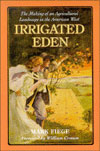book
Irrigated Eden: The Making of an Agricultural Landscape in the America
by Mark Fiege '85 :: University of Washington Press :: Reviewed by Paul Hirt

This gem of a book is actually about the gem state, Idaho—specifically, the Snake River Plain of southern Idaho, where farmers, engineers, lawyers, bankers, and politicians have carved an agricultural landscape out of the parched and dusty sagebrush desert. With deft prose and engaging anecdotes, author Mark Fiege ('85 M.A. Hist.), a professor of history at Colorado State University, systematically traces the 100-year history of the creation and maintenance of the irrigation infrastructure that made farming possible in the Snake River plain. Praising it as "an ingenious, intricate, technological system," Fiege nevertheless offers sober assessments of the economic inefficiencies, ecological losses, engineering foibles, and political finagling that comprise the darker side of Idaho irrigation history.
For such a focused book, there is remarkable breadth here. Fiege discusses the technological system itself; the federal laws that authorized it; the funding schemes that paid for it; the government agencies and private interests that built and managed it; the legal battles over land and water rights that directed the flow of system costs and benefits; the ecology, geology, and hydrology at the foundation of the system; the farmers who grew the crops, the workers who picked them, the processors and distributors who transformed and marketed them; the ways the system functioned as intended and the ways it got out of control; and the individuals and organizations that imagined, explained, defended, criticized, and revamped the system. His story is balanced, complex, and accessible.
An overriding theme of this study is that of the "hybrid landscape." Similar to historian Richard White's thesis in The Organic Machine: The Remaking of the Columbia River, Fiege shows how the irrigated landscape of southern Idaho is "an ambiguous entangling of artifice and nature." Fiege wants to move his readers beyond the conventional view of landscapes as either natural or artificial—the irrigated landscape is neither and both. The supposedly artificial irrigation system is too leaky and unpredictable to be called "plumbing." The degree of "control" exercised by system managers over water and crops is frustratingly limited. And the supposedly conquered "natural world" constantly intrudes on the system in the form of floods and droughts and a biological avalanche of plants, insects, birds, mammals, fish, and fungi, all thriving on the life-giving waters around the reservoirs, canals, and fields—a hybrid landscape indeed.
There are important lessons here. As Fiege puts it, "It is in these apparently unnatural places, I believe, that we most directly confront the reality of our deeply tangled and problematic relationship to the natural world that we inhabit." How we judge that tangled and often problematic relationship is mostly left up to the readers. Fiege reserves his own judgment for the most part, which will delight some readers and disappoint others. No one, however, will go away from this book without having their view of irrigated landscapes enlarged and enriched.
— Paul Hirt, former associate professor, history, Washington State University